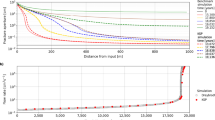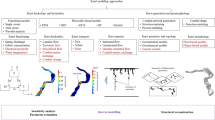Abstract
The contagion model of karst terrane evolution focuses on the environmental implications for a large karst depression population on the Pennyroyal Plain (southern Kentucky) and the adjacent Western Highland Rim (Tennessee) immediately south of the Mammoth Cave Plateau. In karst terranes where the contagion model applies, there is a well-defined infrastructure comprised of hydrologic, structural geologic and geomorphic interacting elements that result in clustered depressions underlain by a radial conduit system. Clusters tend to be randomly distributed and typically contain a parent depression surrounded by numerous daughters.
Groundwater flow is assumed to be turbulent and confined largely to conduits that are 3-dimensionally configured between clusters in a dendritic to trellis network. Parent depressions serve as conduit nodes for collecting groundwater migrating from beneath daughter depressions.
Flow velocities in the 3-dimensional “cluster-cell” conduits exceed those in granular media by several orders of magnitude making pathogen and chemical contaminant migration rapid. Groundwater quality assessment in karst conduit hydrogeologic settings is difficult because monitoring wells are inappropriate. Monitoring wells may have a low probability of intercepting a major conduit and therefore the sampling regime must take into consideration the pulse discharge of pollutants in karst conduits. Representative water quality data must come from springs located near the local base level.
Similar content being viewed by others
References Cited
Aubert, D., 1966, Structure, activitie et evolution d'une doline: Bulletin Societe Neuchateloise Sciences Natural, v. 89, p. 113–120.
Drake, J. J., and D. C. Ford, 1972, The analysis of growth patterns of two-generation populations: the example of karst sinkholes: Canadian Geographer, v. 16, p. 381–384.
Ford, D. C., 1964, Origin of closed depressions in the central Mendip Hills (abs.): International Geographical Congress, 20th, London, England, p. 105–106.
Ford, D. C., and R. O. Ewers, 1978, The development of limestone cave systems in the dimensions of length and depth: The Canadian Journal of Earth Sciences, v. 15, p. 1783–1798.
Kemmerly, P. R., 1976, Definitive doline characteristics in the Clarksville Quadrangle, Tennessee: Geological Society of America Bulletin, v. 87, p. 42–46.
Kemmerly, P. R., 1982, Spatial analysis of a karst depression population: clues to genesis: Geological Society of America Bulletin, v. 93, p. 1078–1086.
Kemmerly, P. R., 1986, Exploring a contagion model for karst-terrane evolution: Geological Society of America Bulletin, v. 97, p. 619–625.
Mackay, D. M., P. V. Roberts, and J. A. Cherry, 1985, Transport of organic contaminants in ground water: Environmental Science and Technology, v. 19, p. 384–392.
McConnell, H., and J. M. Horn, 1972, Probabilities of surface karst.in R. J. Chorley, ed., Spatial analysis in geomorphology: New York, Harper and Row, p. 111–133.
Quinlan, J. F., and E. C. Alexander, 1987, How often should samples be taken at relevant locations for reliable monitoring of pollutants from an agricultural, waste disposal, or spill site in a karst terrane? a first approximation,in B. F. Beck, and W. L. Wilson eds., Karst hydrogeology: Engineering and environmental applications: Rotterdam, A. A. Balkema, p. 277–286.
Quinlan, J. F., and R. O. Ewers, 1985, Groundwater flow in limestone terranes: strategy, rationale and procedure for reliable, efficient monitoring of ground water quality in karst areas.In Proceedings, National Symposium and Exposition on Aquifer Restoration and Groundwater Monitoring: Columbus, Ohio, National Water Well Association, p. 197–234.
White, W. B., 1977, Conceptual models for carbonate aquifers: revisited.In R. R. Dilamarter and S. C. Csllany, eds., Hydrologic problems in karst regions: Western Kentucky University, Bowling Green, Kentucky, p. 176–187.
Williams, P. W., 1972a, The analysis of spatial characteristics of karst terrains.in R. J. Chorley, ed., Spatial analysis in geomorphology: New York, Harper and Row, p. 136–166.
Williams, P. W., 1972b, Morphometric analysis of polygonal karst in New Guinea: Geological Society of America Bulletin, v. 83, p. 761–796.
Author information
Authors and Affiliations
Rights and permissions
About this article
Cite this article
Kemmerly, P.R. The karst contagion model: Synopsis and environmental implications. Environ. Geol. Water Sci 13, 137–143 (1989). https://doi.org/10.1007/BF01664698
Issue Date:
DOI: https://doi.org/10.1007/BF01664698




